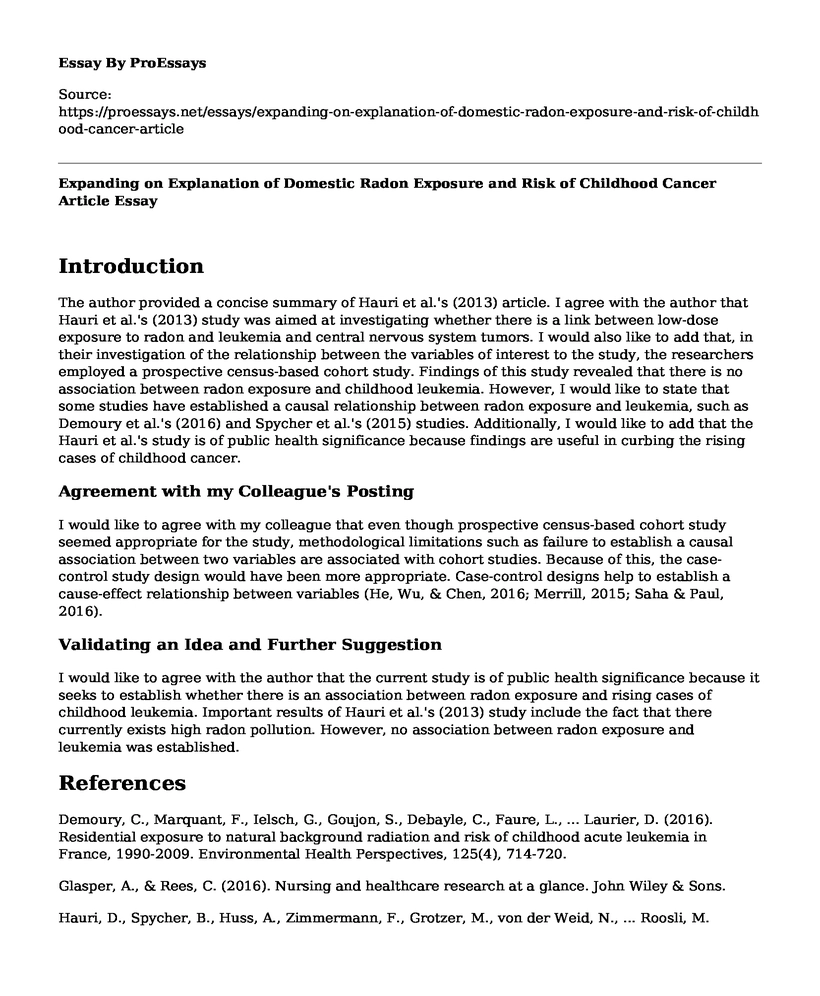Introduction
The author provided a concise summary of Hauri et al.'s (2013) article. I agree with the author that Hauri et al.'s (2013) study was aimed at investigating whether there is a link between low-dose exposure to radon and leukemia and central nervous system tumors. I would also like to add that, in their investigation of the relationship between the variables of interest to the study, the researchers employed a prospective census-based cohort study. Findings of this study revealed that there is no association between radon exposure and childhood leukemia. However, I would like to state that some studies have established a causal relationship between radon exposure and leukemia, such as Demoury et al.'s (2016) and Spycher et al.'s (2015) studies. Additionally, I would like to add that the Hauri et al.'s study is of public health significance because findings are useful in curbing the rising cases of childhood cancer.
Agreement with my Colleague's Posting
I would like to agree with my colleague that even though prospective census-based cohort study seemed appropriate for the study, methodological limitations such as failure to establish a causal association between two variables are associated with cohort studies. Because of this, the case-control study design would have been more appropriate. Case-control designs help to establish a cause-effect relationship between variables (He, Wu, & Chen, 2016; Merrill, 2015; Saha & Paul, 2016).
Validating an Idea and Further Suggestion
I would like to agree with the author that the current study is of public health significance because it seeks to establish whether there is an association between radon exposure and rising cases of childhood leukemia. Important results of Hauri et al.'s (2013) study include the fact that there currently exists high radon pollution. However, no association between radon exposure and leukemia was established.
References
Demoury, C., Marquant, F., Ielsch, G., Goujon, S., Debayle, C., Faure, L., ... Laurier, D. (2016). Residential exposure to natural background radiation and risk of childhood acute leukemia in France, 1990-2009. Environmental Health Perspectives, 125(4), 714-720.
Glasper, A., & Rees, C. (2016). Nursing and healthcare research at a glance. John Wiley & Sons.
Hauri, D., Spycher, B., Huss, A., Zimmermann, F., Grotzer, M., von der Weid, N., ... Roosli, M. (2013). Domestic radon exposure and risk of childhood cancer: a prospective census-based cohort study. Environmental Health Perspectives, 121(10), 1239-1244.
He, H., Wu, P., & Chen, D.-G. (Din). (2016). Statistical causal inferences and their applications in public health research. Springer Publishers.
Merrill, R. M. (2015). Introduction to epidemiology. Jones & Bartlett Publishers.
Spycher, B. D., Lupatsch, J. E., Zwahlen, M., Roosli, M., Niggli, F., Grotzer, M. A., ... Kuehni, C. E. (2015). Background ionizing radiation and the risk of childhood cancer: a census-based nationwide cohort study. Environmental Health Perspectives, 123(6), 622-62
Cite this page
Expanding on Explanation of Domestic Radon Exposure and Risk of Childhood Cancer Article. (2022, Sep 22). Retrieved from https://proessays.net/essays/expanding-on-explanation-of-domestic-radon-exposure-and-risk-of-childhood-cancer-article
If you are the original author of this essay and no longer wish to have it published on the ProEssays website, please click below to request its removal:
- Report Example: Childhood Obesity Among Year 6 Pupils in London Borough of Lewisham
- Research Proposal: The Impact of Poverty on Healthcare
- Research Paper on Drinking Alcohol During Pregnancy
- Human Immunodeficiency Virus Paper Example
- Cultural Diversity: Impact on Social Worker-Client Communication - Intentionality is Key - Essay Sample
- Paper Example on Integrity and Humility: A Nurse Leader's Core Values
- Addressing Medication Errors in Nursing: Enhancing Patient Safety for Older Adults - Paper Sample







